
Бесплатный фрагмент - Biotron is the key to human health
The use of concentrated radiation of young organisms for health improvement and prolongation of active life
UDC 576.534; 591.139
BBK 28.703
Komrakov Evgeny V., Prokhorov Leonid Yu. Biotron is the key to human health. The use of concentrated radiation of young organisms for health improvement and prolongation of active life. Moscow/Ekaterinburg, Russia.
A brief history of attempts to rejuvenate people, from ancient times to the present day, is described. The various methods by which they tried to rejuvenate old people are listed. Currently, a lot of data is accumulating on the distant impact of some biological objects on others. The concentration of this impact is of key importance. For this purpose, devices called Biotron or Bio-Chamber have been invented. They concentrate and thereby enhance the effect of young seedlings of cereal plants on the human body and experimental animals. As a result, experimental animals, such as mice, live 25% longer and even in old age remain young and physically active, unlike decrepit and sedentary control animals. EKOM Biotrons of different sizes and efficiency are described. There are Biotrons the size of a room, there are professional and personal Biotrons specifically for the home. The session time varies from 20 minutes in a Sedentary 8-reflex Biotron to 8 hours (night) in a Personal Biotron. The influence of EKOM Biotrons on human health is described.
The book is intended for everyone who is interested in gerontology, ways of rejuvenation, recovery and increasing active longevity.
It is not a medicinal product. Consult a specialist.
Keywords: gerontology, life span, life expectancy, longevity, prolongation of active and healthy life, healthy old age, anti-aging, aging, rejuvenation, Biotron, Bio-chamber, Jiang Kanzhen, Komrakov, health improvement, joint diseases, spine, sleep improvement, diabetes mellitus, libido, restless legs syndrome, genitourinary system, mice, nematodes.
2022 © Komrakov Evgeny V,
2022 © Prokhorov Leonid Yu.
A photo of a 4-reflex Biotron EKOM E.V. Komrakov was used for the cover. The design of L. Yu. Prokhorov.
The history of attempts to rejuvenate people
Since the biblical times of King David, people have tried to use young organisms to prevent aging, improve health and even for rejuvenation. Most often, young innocent girls were used for this purpose. For a long time it was believed that their breath restores youth, drives away old age and prolongs life. In the Old Testament, it is described that when King David (1035—965 BC) grew old, they found him a very beautiful young girl, Avmsaga Shunammite, who took care of him, slept with him, but the king did not know her. The last queen of Hellenistic Egypt, the great Cleopatra VII Philopator (69–30 BC) from the Macedonian Ptolemaic dynasty (Lagids) constantly surrounded herself with babies and claimed that they supported her youth. Similar methods were used by many rulers, for example, Genghis Khan and many others.
The story of King David’s communication with the beautiful Avmsagu Sunamite became a true legend and encouraged many elderly people who were looking for the elixir of youth. The original method of rejuvenation has since been called “sunamitism”.
Sunamitism experienced its real renaissance in the XVII century AD, especially in France, where a fairly massive business was even organized to rejuvenate old people.
There was an opinion that older people become energy vampires. The elderly body tries to compensate for the lack of its energy at the expense of the energy of others, in most cases, young people. Despite the fact that no positive results of rejuvenation with the use of such techniques have been registered, it seems that there is some truth in this. This technique clearly lacked one main element — the concentration of bioenergy from young organisms to old ones.
In 1889, the French scientist Charles Eduard Brown-Secard injected an extract from the seminal glands of a dog under his skin. He officially announced a new method of rejuvenation invented by him. At first it was perceived as a sensation. However, if there was an effect, it was very short-lived. Brown-Sekar began to grow old very quickly and died five years later at the age of 76.
At the beginning of the last century, the Austrian scientist, biologist Eigen Steinach (1861—1944) became the ruler of minds in the scientific world. Ligation of the vas deferens has a strong stimulating effect on the male gland. To this end, he performed operations of dissection of the testes and ligation of the vas deferens, believing that, entering the tissues, sex hormones will be absorbed into the blood more intensively and thereby will have an effective rejuvenating effect. Steinach’s highly publicized operations also soon brought disappointment. Their positive consequences, if they took place, were far from as great as the advertisement promised.
Russian-born French surgeon Sergey (Samuel) Abramovich Voronov (1866—1951) became famous for the technique of grafting monkey testicular tissue to human testicles. Initially, for the purpose of rejuvenation, S.A. Voronov performed operations to transplant the testicles of executed young criminals to very rich elderly people. When the demand for such services began to significantly exceed the supply, he began to use tissue from the testicles of monkeys for transplantation. To cover the ever-growing demand for biological material, S.A. Voronov opened his own monkey nursery on the French Riviera. Among his patients were well-known businessmen, artists and politicians at that time. As contemporaries testified, the initial effect of the operations was amazing. Elderly people literally came to life, there was a huge queue for the famous surgeon. However, as it turned out, the operations brought only a temporary effect, and subsequently led to necrosis of the transplanted tissue. Repeated surgery gave an even more short-term effect. Subsequent operations, in general, lost all meaning.
In the 20th century and in recent decades, scientists have become more active, trying to somehow use young organisms to prolong life and rejuvenate old ones. What kind of experiments have not been carried out by scientists to rejuvenate the old body with the help of a young one. Blood was transfused, cells were transplanted, especially stem cells, spleen, skin, etc. were transplanted.
Hundreds of experiments were conducted when old and young mice were stitched together, organizing a single blood circulation (parabiosis). Young blood cells, young hormones and other young components produced by a young mouse were constantly circulating in the old body. The old mouse was only slightly rejuvenated and the life span increased slightly, but the young mouse was “infected” with old age from the old one.
Many scientists have investigated the well-known phenomenon of induction of physiological processes in living cells and tissues under the influence of a signal transmitted to them from other living cells without direct contact of culture media and without the participation of chemical signal carriers. An overview of the effects of this type is given in the article Van Wijk R. (2001). The fundamentals of the phenomenological theory of biophotonic interactions are presented in the monograph Popp F.A. et al., (1992).
One example of this effect is the so-called “mitogenic” effect described by Gurwitsch A.G in a 1926 monograph (Gurwitsch, 1926), according to which one group of plant cells in the mitosis phase induces mitosis in another group of cells, while both groups are separated by a quartz partition impervious to liquid medium.
The effect of animal cells on each other is also known, in particular, the influence of developing embryos of one organism on the embryogenesis of embryos of another organism, that is, the so-called distant interaction between animal cells (Burlakov, 1999).
According to general opinion, the most likely carriers of this type of effects are low-intensity electromagnetic radiation (see Biophotons monograph edited by Jiin-Ju Chang et al. (Biophotons, 1998) and especially the article in the book: Bei et al., p.57–64).
Recent research by a group of scientists led by Michal Cifra from the Institute of Photonics and Electronics (IPE) has also unequivocally shown the presence of electromagnetic radiation from living objects.
Patent RU 97636 by the author Zakharov Yu. A., (2009) describes a device for transmitting electromagnetic radiation from young seedlings to the skin of the face and head and there are some theoretical justifications.
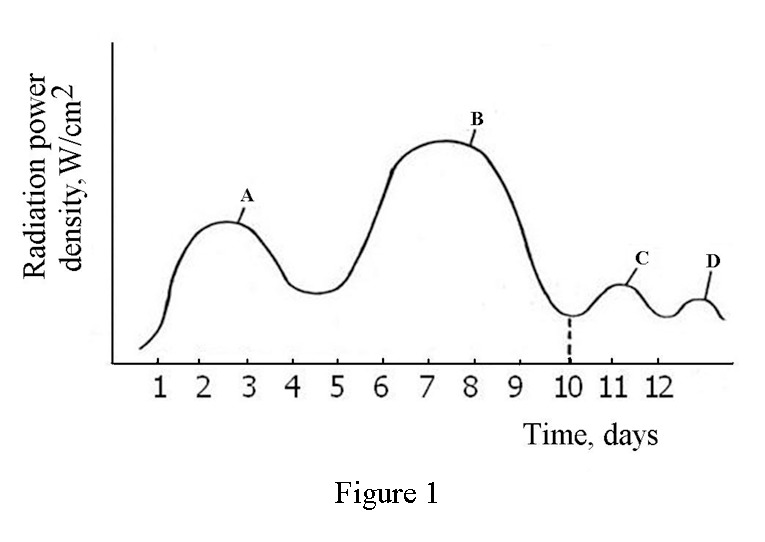
In the patent RU 2108028 by the authors Kotov B.S. and Gavinsky Yu. V. (1996), the results of measurements of biological radiation of sprouts of various plants in the wavelength range from 2 microns to 2 mm are given (Fig. 1). The radiation power density (W/cm2) is indicated on one axis, and the age of the sprouts is indicated on the other axis in days.
However, all these scientists have only recorded the presence of radiation from living objects and the fact that it affects other living objects. None of them have tested how radiation from young organisms can affect an old or sick organism.
It is known that elementary particles are both matter and a field at the same time. Russian scientist Pyotr Goryaev believed that genes also have both a material and a field component. When an old or sick organism is exposed to concentrated electromagnetic radiation from living young organisms, specific significant positive changes occur. This may be the correction of information wave exchange failures between cells and organs that appear with aging or disease. There is an opinion that the genome is just a disk on which important wave information is recorded.
Jiang Kanzhen’s Method
The only brilliant Russian scientist of Chinese origin, Jiang Kanzhen, guessed to use concentrated bio-radiation of young organisms to prolong life, improve health and rejuvenate the old or sick. As donors in his experiments, he used young organisms, most often plant seedlings.
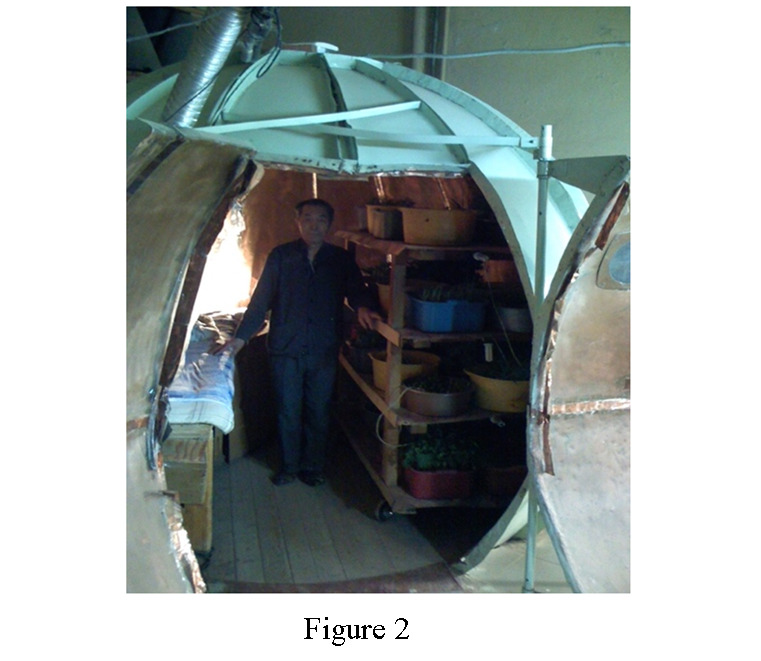
In recent decades, he has used a device in the form of a copper ball with a diameter of 3.6 m (Fig. 2). Journalists called this copper ball mysterious and wrote that attempts to copy it failed.
A wooden floor was made in this ball at a height of about 90 cm. A bed for the patient was installed in one focal area, and a stand with plants was installed in the other focal area. Jiang claimed that the principle of operation of this ball is that from one focal zone in which plants are installed, radiation, reflecting from the part of the sphere closest to the plants, is transmitted to the part of the sphere that is near the bed and concentrates on the patient.
Let’s figure out what’s really going on.
Figures 3 and 4 show a sketch of the section of the Jiang Biotron. In these sketches, three-dimensional, spherical focal zones are depicted in yellow, which are formed near the middle of the radius of the sphere (90 cm from the center). The estimated thickness of these focal zones is 13 cm. Fig. 3 shows that the focal zone, due to the curvature, practically does not capture the patient’s head and legs. And in Fig. 4, the focal zone strongly extends beyond the patient. The height of the stand with plants is 180 cm, and the height of the focal zone in the middle of the radius will be 90 cm. At the same time, the height of the recumbent patient is only about 20 cm. Consequently, only about 25% of plant radiation works for the patient in this plane. The rest of the radiation flies by. Figures 3 and 4 shows: 1 — a stand with plants, 2 — a copper sphere, 3 — active parts of the sphere, 4 — a patient, 5 — a bed, 6 — a door in Fig. 3 or a foundation in Fig. 4; 3, 7 — spherical volumetric focal zones.
The focal zone 7, which is also located inside the plant stand, has an estimated thickness of 13 cm. At the same time, the thickness of the stand with plants is 70 cm. Then the focal zone will occupy only 20% of the total volume of plants.
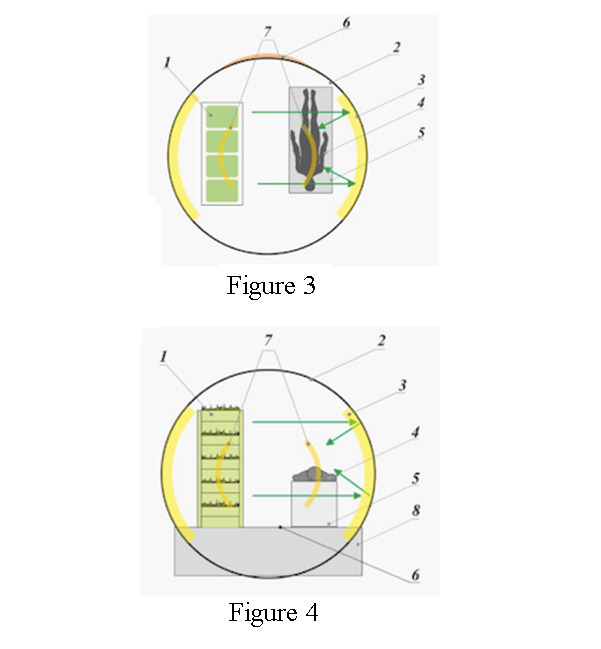
If we proceed from this, then only 20% of plant radiation will fall on the active part of sphere 3 closest to the stand. But that’s not even the point. When plants radiate from the focal zone to the active part of sphere 7 near plants, radiation is de-concentrated, then this radiation is reflected from this part of the sphere and, flying through a stand with basins with earth and plants, falls on the active part of sphere 7 near the bed. Further, the radiation is concentrated on the patient in the focal zone 7. Thus, there is a simple transmission of radiation from plants to the patient without any concentration (first deconcentration, and then concentration) and with large losses from double reflection, passing through the stand and a long distance. This is equivalent to the fact that the patient is just 5.4 meters away from the plants (90 cm +360 cm +90 cm). Based on this, we can draw an unambiguous conclusion that Jiang mistakenly described the principle of operation of the Biotron. In fact, all plants from stand 1 radiate directly to the active part of sphere 3 near the bed, and this part of the sphere effectively concentrates this radiation on the patient (green arrows in the figure). And the radiation of plants in the other direction is concentrated by the active part of the sphere near the plants and forms a focal zone inside the stand with plants, which makes no sense.
Until 2004, Jiang did sessions on Biotron for 8 hours. The recommended course was 30—40 such sessions 2 times a year. It is clear that it was impossible for both patients and businesses to regularly use Biotron in this mode. Jiang was working with specialists from Khabarovsk Technical University to manufacture an electronic amplifier for his Biotron. In 2004, such an amplifier (with white noise emission) It was created and Jiang began to apply it. The session in the Biotron was reduced to 45 minutes.
The principle of operation of the amplifier was not fully understood. From the description of the amplifier: “A method of amplifying the radiation of a biological object, characterized in that for influencing objects using the invention ‘Biotron Jiang’, patent No. 2090613 RU (Jiang Kanzhen, 1995), additional irradiation of objects placed in a permanent magnetic field is applied by electromagnetic radiation from generators of ‘white noise’ in meter, microwave- and extremely high frequency bands, causing the effect of double electron-nuclear magnetic resonance in objects, while the objects themselves, located in the focal zones of the Jiang Biotron, mutually irradiate each other with an informative biological electromagnetic field, causing a four-element electron-nuclear magnetic resonance in the system, additional electromagnetic energy through the effect of a four-element electron-nuclear magnetic resonance turns in an informative biological electromagnetic field from objects, the effect of strengthening the biological electromagnetic field is obtained.” Jiang’s attempt to patent an amplifier with this description failed.
Jiang believed that using such an amplifier could be quite harmful. He limited the session time to 45 minutes and the number of sessions in the course to 21, did not allow consecutive sessions. He insisted that the patient receive 7 sessions, then a break of a week, then 7 sessions, again a break of a week and the last 7 sessions. Jiang also did not allow courses to be held more than 2 times a year. At the same time, Jiang himself worked around this amplifier for 12 hours every day. Experts warned him that it was harmful. The most likely cause of Jiang’s death in 2018 is prolonged exposure for 14 years to powerful EM radiation from this amplifier. He died of pneumonia at the age of 85, most likely due to a low level of immunity.
Komrakov visited Jiang in Khabarovsk at the very end of 2008. He completed a course of 21 sessions of 45 minutes in a Biotron with an amplifier. After that, vision improved significantly (it was +2.5) and never used glasses again. The pressure has also stabilized and some other parameters have improved. Komrakov believed in this technology and tried to negotiate with Jiang about cooperation. Jiang refused. Komrakov had to start looking for a more efficient version of the Biotron design. Six months later, he came up with such a design and in September 2009 received priority for the invention. The main idea of the invention was to transfer the active part of the sphere, which was located near the plants at a radius distance. Then the focal zone, which was inside the stand with plants, was transferred along with part of the sphere. This made it possible to form a joint focal zone in the center of the device. Figure 5 shows a view of the Biotron from patent RU 2533058 (Komrakov, 2012). The joint focal zone 6 is formed in the middle of the radius of both reflectors in the center of the device, where the bed for the patient is installed. Stands with plants are installed either on both sides of each reflector, or on one side next to the bed. The first EKOM Biotron under patent was built in 2010 in the city of Perm (Russia). Figure 6 shows the last EKOM Biotron of this design, which was built in Vietnam in 2018. The dimensions of the EKOM Biotron chamber were 4x4 meters. Due to the use of two reflectors, many times more plants, and a two-sided focal zone, the efficiency of the EKOM Biotron of this design was about 15 times more efficient than Jiang’s Biotron. This made it possible to use the EKOM Biotron without an amplifier and do courses of 12 sessions with a session duration of 1 hour.
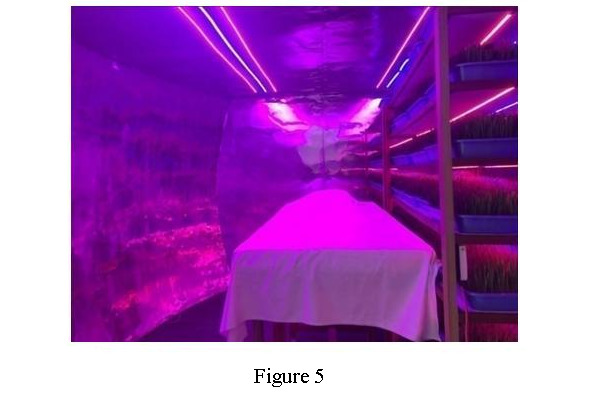
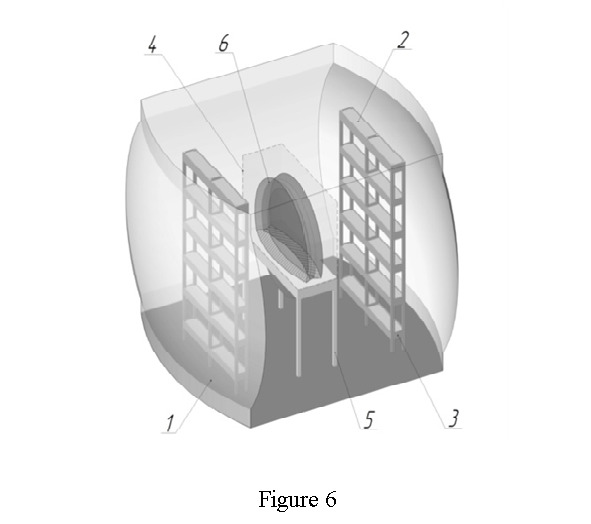
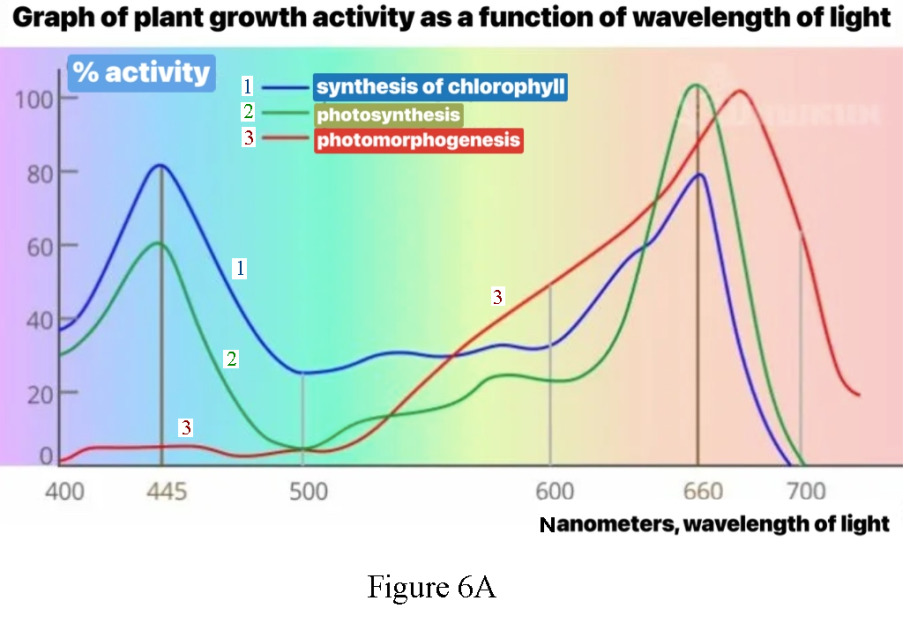
The strange color of the EKOM Biotron lighting is due to the fact that the activity of the main parameters of plant growth peaks in areas of blue and red light (Fig. 6A). The most effective is a mixture — blue 25% and red 75%. Now special LED phytolamps and phytolents are being produced. In 2010, they were not released and had to make lighting consisting of 2 red and one blue LED strip.
The first two EKOM Biotrons were made of copper, as well as Jiang’s Biotron. Then, both EKOM Biotrons and compact Biotrons were made of aluminum. This is due to the reflective properties of the metal. The radiation of plants was discovered by the Russian scientist Alexander Gurvich in 1923. To put it simply, he did experiments with onions. When two bulbs were next to each other and one of them was infected with rot, then the second bulb was infected with rot. When two bulbs were hermetically separated by glass, no infection occurred. When two bulbs were hermetically separated by quartz glass, infection occurred. From this, Gurvich concluded that there is information interaction between the bulbs through radiation in the ultraviolet (UV) range, which was later confirmed. Gurvich called the detected radiation mitogenetic. Jiang said that the best metal for Biotrons is gold, silver is possible, and copper is possible. However, judging by the graph of the reflectivity of different metals (Fig. 7), hard UV with wavelengths from 100 to 250 nanometers effectively reflects only aluminum. Neither gold, silver, nor copper in this range effectively reflect UV.
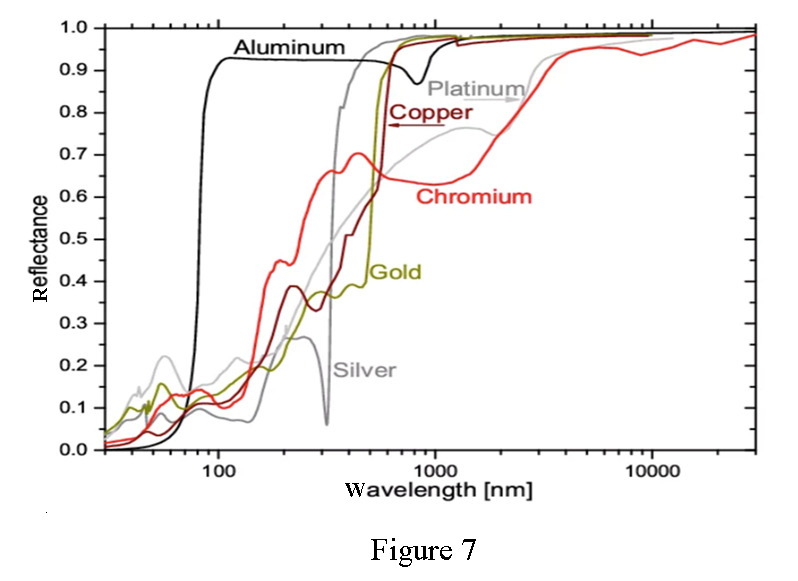
Plants and other young organisms that can be used as donors in Biotrons emit not only in the UV range. They can emit both in the infrared (IR) and terahertz ranges, UHF, microwave and even in ultrasound. In these ranges, copper, like aluminum, works well. But when using copper, the UV range is lost.
How is the volumetric focal zone of the Biotron formed?
The basic idea of all EKOM Biotrons is that the reflectors are installed at a distance of the radius of their curvature. This makes it possible to form a joint focal zone in the center of the device, where the person lies. An example of such a device is shown in Figure 8.
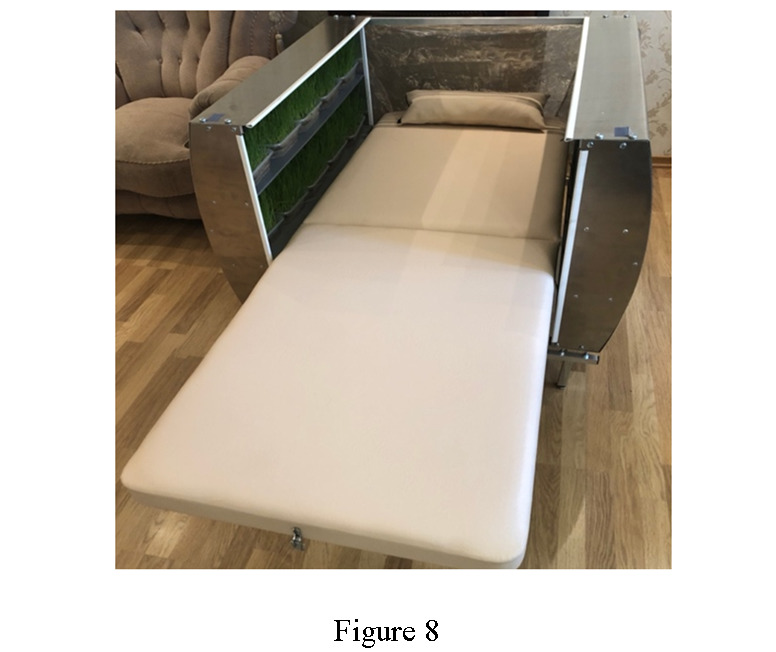
The area of each reflector is only 0.6 m2. And in reality, many hundreds of square meters of reflectors work on the formation of the focal zone. This section describes exactly how it works.
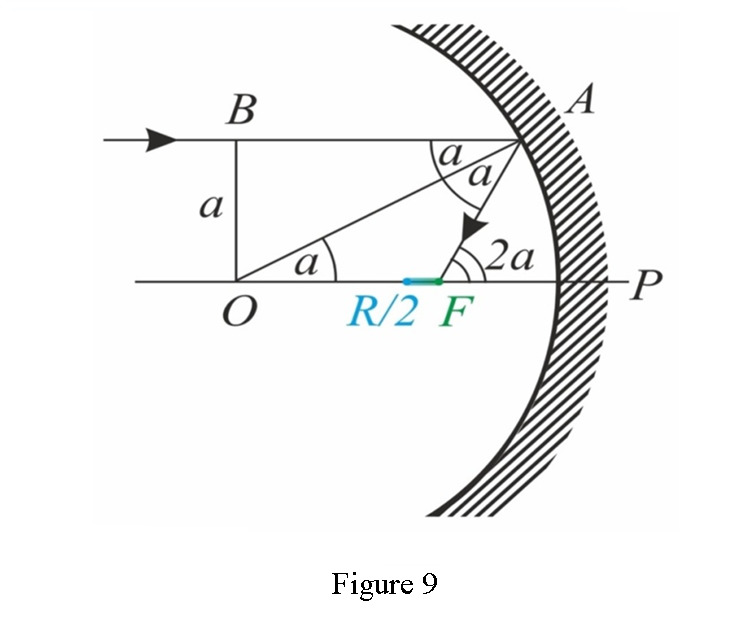
Figure 9 shows a part of the sphere and the optical axis OP from its center. Parallel to this optical axis, a beam AB is drawn at a distance of a. The greater the distance a, the closer point F is to the sphere (the angle of incidence is equal to the angle of reflection).
If we take several parallel rays, they will form a line on the optical axis from point R/2 to point F with a length that depends on the distance a. The length of this line can be accurately calculated depending on the distance a and the radius R of the sphere by the formula:

This formula and its conclusion are given in the description of the patent RU 2533058 (Komrakov, 2012). The maximum distance a for the EKOM Biotron is 1500 mm, and for the Jiang Biotron 800 mm (half the length of the stand with plants). The estimated length of the focal line from point R/2 to point F will be 16 cm for the EKOM Biotron, and 13 cm for the Jiang Biotron.
The formation of such a line from point R/2 to point F is called “spherical aberration”. Spherical aberration is a serious drawback in most devices related to energy concentration. However, in the case of a Biotron, spherical aberration is a significant ADVANTAGE, since it allows you to form a volumetric focal zone with a size comparable to the zone of location of all major human organs. If we consider, for example, a parabola instead of a sphere, then it will form a focus at one point, and not a focal line. And this is a big disadvantage for Biotron. In addition, the parabola has a huge disadvantage due to the fact that it’s only one main optical axis and radiation only parallel to this axis will concentrate. The rest will dissipate. In the sphere, this is not the case at all, but more on that below.
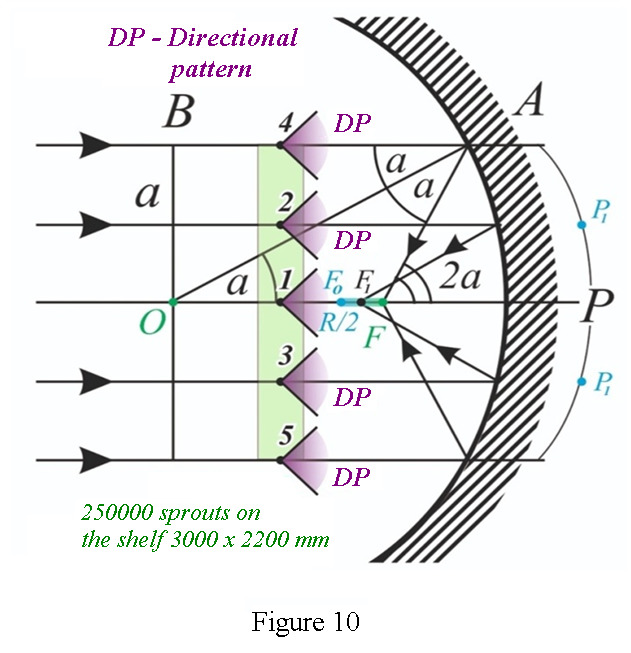
In Figure 10, we have added a few more elements. Imagine a stream of rays parallel to the optical axis OR. In the vast majority of devices used in the world, such a stream comes from an infinitely remote point source (communications, radar, optics). It’s a classic. However, a Biotron is not a classic and the same stream of parallel rays is formed from a stand with plants (shown in green), which is installed in the opening of a spherical reflector, of course with some distortions due to the close distance of the distributed source from the reflector, which will lead to a certain decrease in the quality of concentration, which is even useful for Biotron technology, where it is necessary to create a volumetric focal zone. All plants available on the stand in a Large Biotron (Fig. 6), of which approximately 250 thousand, radiating parallel to the optical axis of the OP will form a focal line FoF. Figure 10 shows the course of the rays from the blades of grass, which are located at points 1—5. At the same time, to form this focal line, a part of the sphere P1 with a size of 3000x2200 mm (projection of the size of the stand with plants on the sphere) will work. Thus, there will be 250 thousand parallel rays from 250 thousand blades of grass per area of the sphere with a size of 3000x2200 mm. And ALL these rays will be reflected from the sphere and form a focal line FoF 16 cm long!
If it had been a parabola, that would have been the end of it. All these 250 thousand rays would be honestly focused at one point. Radiation from other directions will dissipate. But that’s NOT how the sphere works AT ALL!
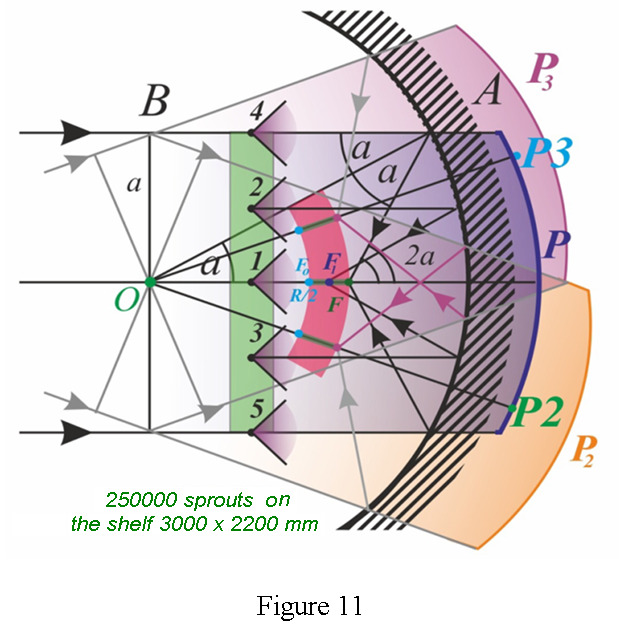
Now consider Fig. 11. It is clear that from the center of the sphere to its surface, you can draw as many completely equivalent optical axes as you like. For example, the OR2 and OR3 axes. Then all 250 thousand plants from the stand will radiate together and parallel to these axes and will also form two focal lines on the optical axes OR2 and OR3 with a length of 16 cm. At the same time, a part of the sphere P2 will also work on the formation of the focal line on the OR2 axis with a size of 3000x2200 (projection on the sphere of the stand with plants in the direction of the OR2 axis). And for the formation of the focal line on the OR3 axis, a part of the P3 sphere with a size of 3000x2200 mm will work by analogy.
Also, from the center of the sphere O, you can draw many other axes (to the left, to the right, above, below). And, since 250 thousand plants will radiate parallel to these new axes, a focal line of 16 cm long will also be formed on all these new axes with the help of a part of a sphere measuring 3000x2200 mm! And these are thousands of optical axes within the angular aperture of the reflector in the form of a segment of a spherical surface. After all, an axis half a degree apart from the other will already form its own, completely independent focal line from the radiation of all 250 thousand plants from another direction, and another completely independent part of the sphere with a size of 3000x2200 mm will work on the formation of this focal line. Thus, more than 60,000 m2 of the reflector surface will be used to form a joint focal zone of the EKOM Biotron. For example, the angular aperture of the EKOM Biotron reflector is 40x600. If the optical axes are in half a degree, then 80x120 = 9600 optical axes will work on the reflector. If a completely independent part of the 3000x2200 mm reflector works on each such axis, then the total area will be more than 60,000 m2 (3 m x 2.2 m x 9600 = 63360 m). Only half of the reflector area will work on the edges of the reflector. Then the total effective area of one reflector will be more than 30,000 m2. And two reflectors are more than 60,000 m2.
Thus, a spherical volumetric focal zone with a thickness of 16 cm, marked in red, will be formed. And a very high concentration. In such a situation, a parabola will honestly concentrate radiation parallel to its main optical axis from 250 thousand plants to a point and THAT’s IT. The radiation from the blades of grass from other directions of the parabola will not concentrate. For example, if a TV parabolic antenna tuned to a satellite is rotated at least a couple of degrees, then the signal from the satellite will disappear. Therefore, if we imagine the technical possibility to install thousands of parabolas with a size of 3000x2200 mm each with thousands of optical axes that will all be directed to one focal zone, then it would probably be possible to get about the same effect. Using only one parabola for Biotron technology is thousands of times less effective than using only one sphere.
Based on this, it can also be said that Jiang did not fully understand the geometry and the principle of the formation of the focal zone in his spherical Biotron, since he used two parabolas installed opposite each other for his last Biotron. This design is also described in his patents. If he understood what is described above, he would not spend a lot of money on a construction of parabolas, which practically does not work at all.
Well, then everything is simple. It remains to add another sphere opposite the first one (on the left) at a radius distance, which, by complete analogy with the first one, will form another volumetric spherical focal zone with a thickness of 16 cm (highlighted in yellow, see Fig. 12). And then there will be a joint focal zone with a size of 1200x600x320 mm of very high concentration where the bed for the patient is installed.
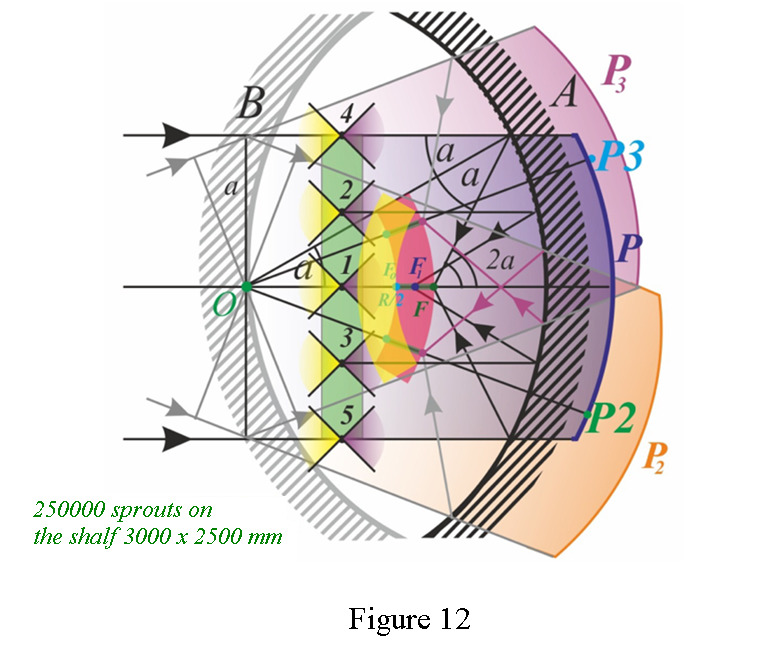
The following 3 figures from the description of the patent RU 2533058 (Komrakov, 2012) show what has already happened in the EKOM Biotron (side view, top view and general view — Fig. 13–15). The following designations are used in these figures: 1 — spherical reflector, 2 — distributed radiation source, 3 — stand for a distributed radiation source, 4 — object, 5 — means for placing an object, 6 — focal zone, 7 — camera.
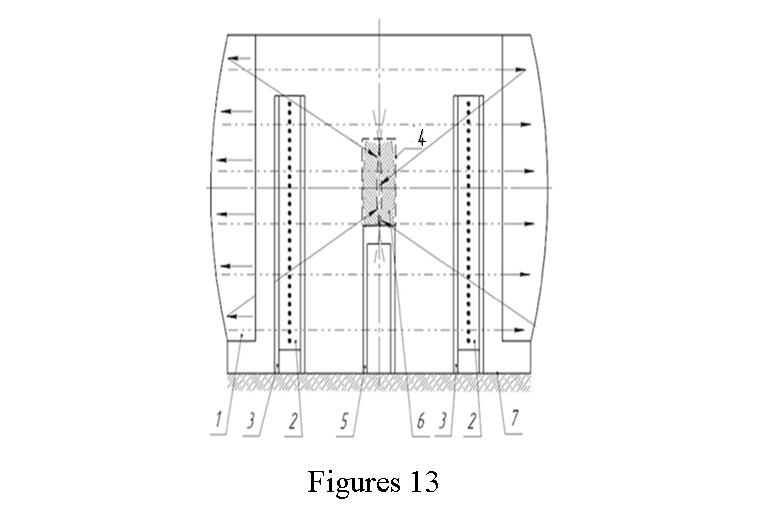
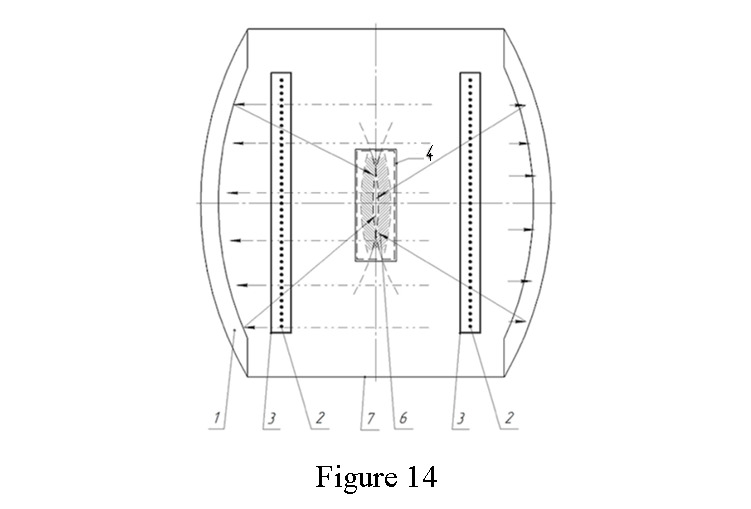
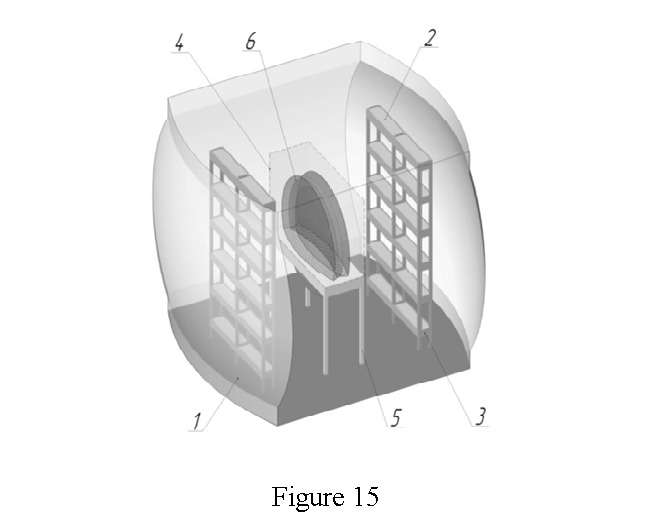
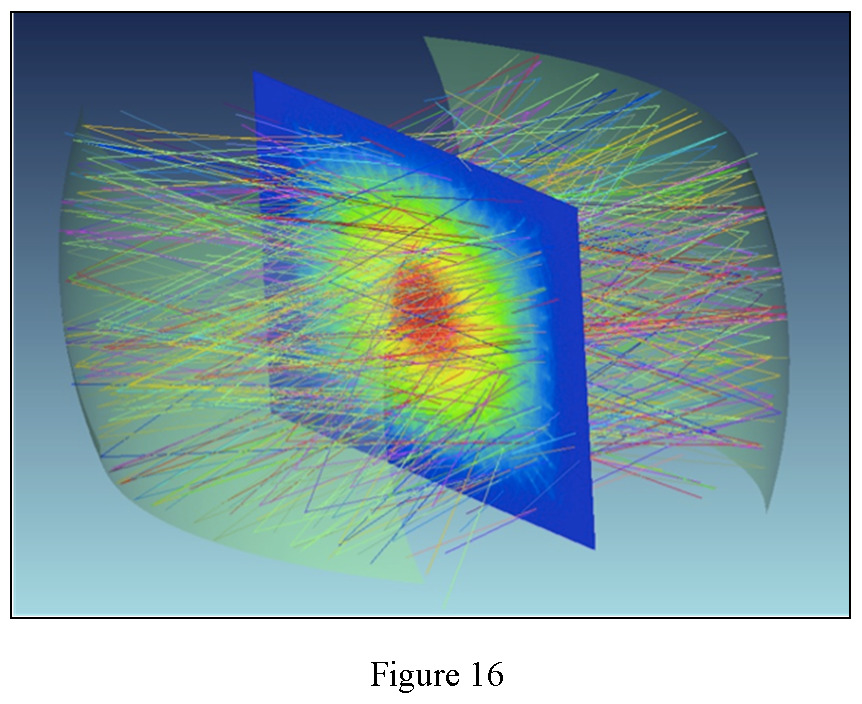
Figure 16 shows the results of modeling the focal zone of a device with the same geometry as the EKOM Biotron in the optical range using the ZEMAX program.
In fact, everything is of course somewhat more complicated. In reality, there are no such separate elements, such as separate focal lines. Everything is integral there. But the overall dimensions of the focal zone are considered absolutely accurate. And it is very difficult to explain to someone the integral essence of the formation of the focal zone. And so, on the basis of school geometry, not everyone understands this.
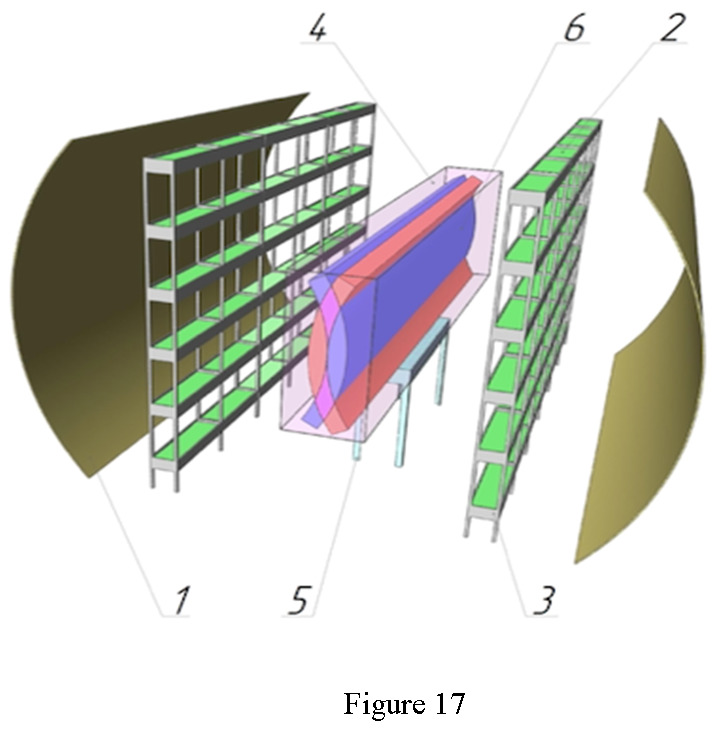
Figure 17 shows a schematic representation of the device from the description of the patent RU 2533058 (Komrakov, 2012) with cylindrical reflectors. Biotrons with cylindrical reflectors in the vertical plane will work in the same way as with spherical reflectors and Fig. 9—12 are completely suitable for cylindrical reflectors. In the horizontal plane, the focal zone will be formed by reflecting the radiation of all plants in this plane. In the horizontal plane, the efficiency of cylindrical reflectors will be 2 times less, since the law “the angle of incidence is equal to the angle of reflection” works there. The overall efficiency of a device using cylindrical reflectors will be 75% of a device using spherical reflectors of the same size. In this case, the cylindrical focal zone will be even slightly larger than the length of the cylindrical reflector.
However, for example, if the length of a spherical reflector is 1 meter, its focal zone will be 0.5 meters long, since it is formed in the middle of the radius. Such a length of the focal zone is not enough for a person. Then you will have to increase the size and radius of the spherical reflector to obtain a longer focal zone. And this leads to an increase in the size of the device and the distance from the source to the patient. It is known that the distance works to reduce the power squared. Increasing the distance by only 30% results in a 70% reduction in efficiency. Thus, the use of cylindrical reflectors has certain advantages and allows you to design more compact devices with an efficiency no worse than devices using spherical reflectors.
Compact versions of Biotrons
Since 2016, various compact versions of Biotrons have been developed and produced. The first was a recumbent Biotron with a horizontal arrangement of reflectors (Fig. 18–20).
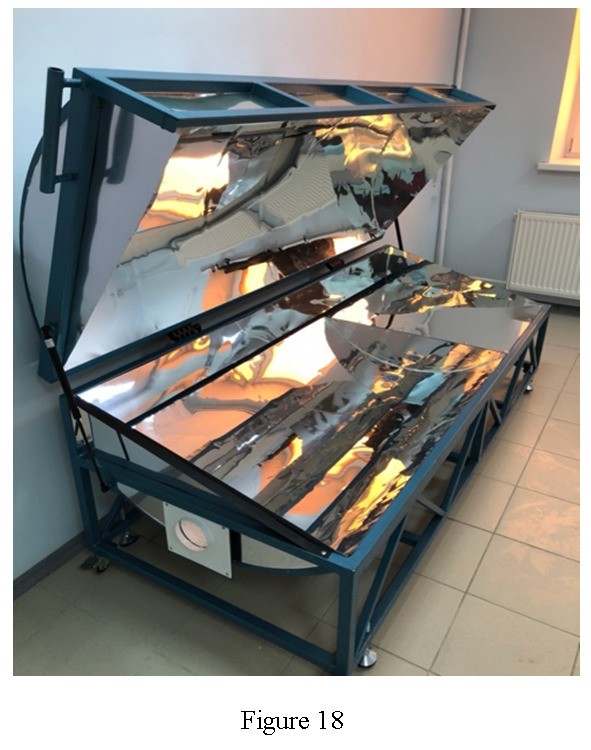
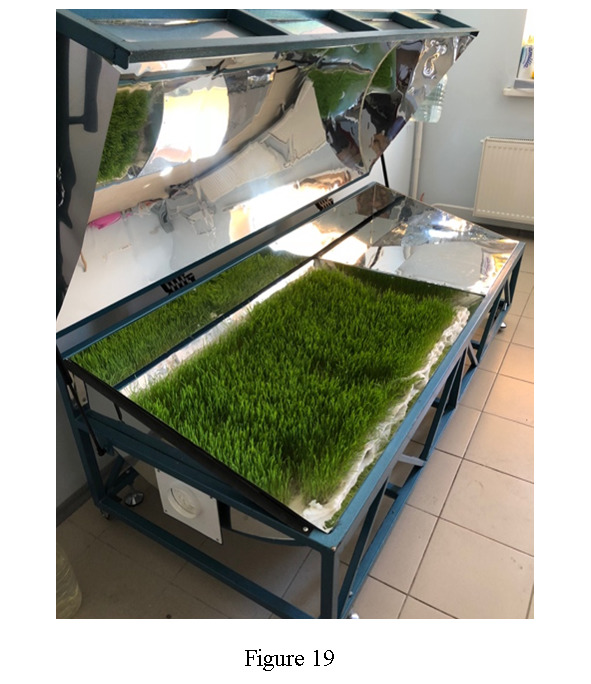
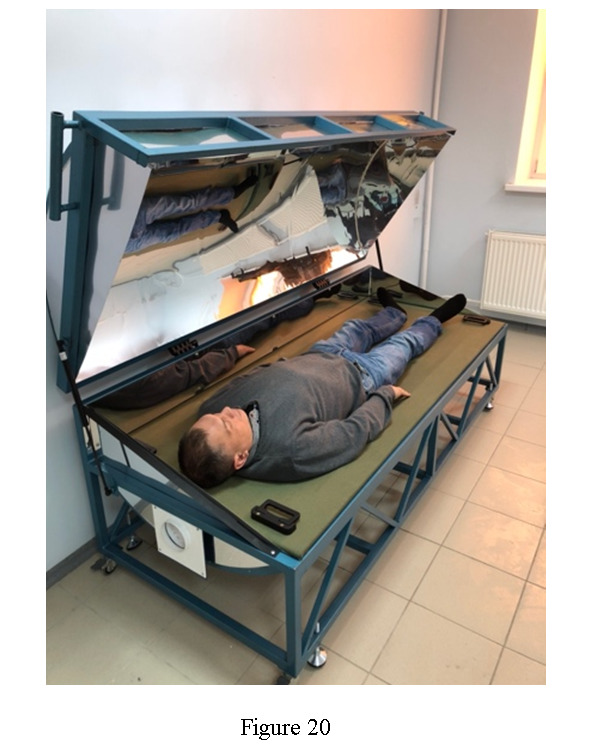
Reflectors made of mirror aluminum were installed at a distance of the radius of their curvature (Fig. 18). Plants were grown on the lower reflector (Fig. 19). A plywood frame with a stretched tarpaulin was installed over the plants, on which the patient lay down (Fig. 20). 3 such Biotrons were produced. They were not very comfortable, because the patient was in a small enclosed space. But these Biotrons were effectively used for experiments with mice, nematodes, chicken embryos and germinated seeds.
The next compact model of the Biotron was a Sedentary four-reflex Biotron. Figure 21 shows a schematic image from the description of the patent RU 2533058 (Komrakov, 2012). Figure 22 shows a photo of a Sedentary Biotron, which was made in Vietnam in 2019. Only three such Biotrons were made. The production technology was not very successful. One Biotron works in Germany at the Inakarb clinic, and another in Moscow at the Vedov clinic. According to Professor Edinger from the Inakarb clinic, who also has a recumbent two-reflex Professional Biotron (Fig. 29–31), Patients like the sedentary Biotron more than the recumbent one. They are now ordering another Sedentary Biotron of a new design to their branch.
Бесплатный фрагмент закончился.
Купите книгу, чтобы продолжить чтение.